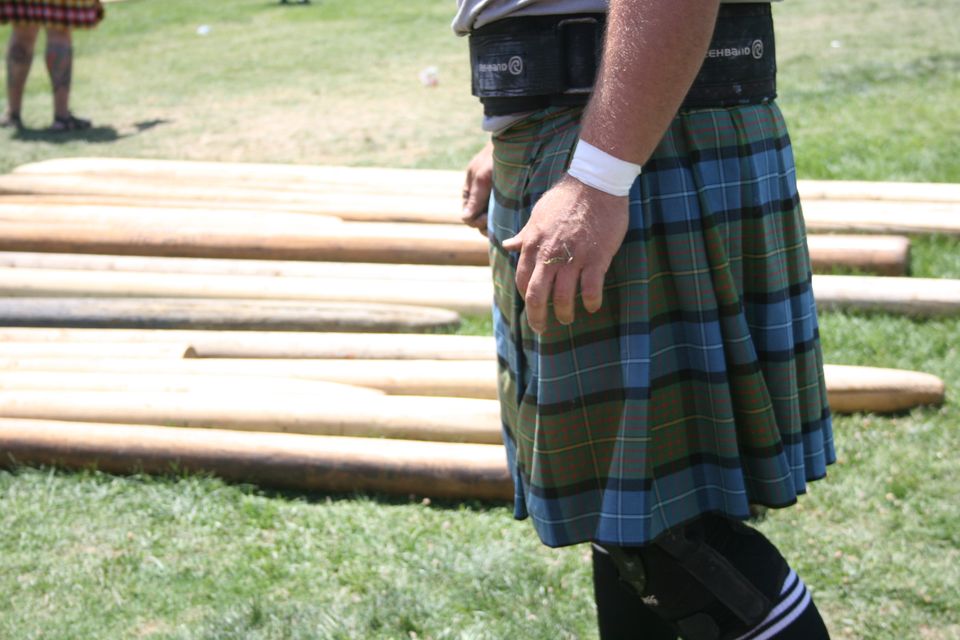Almost all the Highland Games’ events involve throwing things that should really be left alone. There’s the Hammer Throw, the Stone Putt, the Braemar Stone Putt (like the Stone Putt but with feet planted), the Weight Throw (a lead weight attached to a handle with a chain), Weight Over the Bar (a small anvil thrown overhead) and the Sheaf Toss (a hay-stuffed burlap bag lofted with a pitchfork). Riveting as these events are in their way, I am only here at ScotsFest—which has been held in Southern California every Memorial Day weekend since Calvin Coolidge was president—to witness the most idiosyncratic Scottish event of them all: the Caber Toss.
The Caber Toss, unlike the other highland throwing events, is a matter of accuracy, not of distance or height. The purpose of the toss is to accomplish a “turn.” According to the official rules sanctioned by Scottish-American Athletic Association, “A valid turn is when the small end of the caber passes through the vertical position and falls away from the competitor to land within the 180-degree radius, between 9 o’clock and 3 o’clock.”
In other words, the tosser—yes, that is the correct term—tries to up-end the log and have it then fall directly away from him. The goal is to score a nooner: “The ‘clock face method’ of judging shall be used” the rules explain. “The caber in a perfect toss will pass through the vertical position and land with the small end pointing directly at 12 o’clock.”
The games have been going on for hours before I arrive, and the first tossers I watch compete are the novice class. As a group they seem like gym rat locals making good on a dare. They are generally top-heavy and broad waisted—a flock of Coach McGuirks milling about in kilts. (The rules require that every competitor wear a kilt. Rental kilts are available for five dollars.) The judge chooses from among about 20 logs strewn on the grass. They range from 15 feet and 70 lbs to one labeled “THE FAT BASTARD,” which weighs in at 130 lbs and is 18’ 10” long.
A medium-sized caber is chosen, and each novice competitor makes his first of three tosses. In each case, two men carry the log to the tosser. With the narrow end wedged against the tosser’s foot, the two assistants lift the far end of the caber and walk their hands down, raising the log—picture Iwo Jima—until it is vertical and resting against the athlete’s shoulder. The tosser then works both hands under the bottom end, and lifts it the way he might boost someone over a wall, until the downward end is solar plexus high. With the log braced against his shoulder, the tosser staggers forward into a run, tips the log forward, and throws his end up into the air. The first-round caber is too much for the novices, and none manages a turn.
The next round, the judge gives them a much smaller log, but this one’s too easy, and everyone gets it to up-end and fall. Before the third and final round, the athletes congregate around the row of cabers until the judge selects a happy medium between the two logs they have already attempted. This one seems right; only two of the dozen competitors manage to make the turn.
The novices are a backslapping group—one tells me he’s here with his “powerlifting club”—and the competition is all grins and glad-handing and mugging for friends. But when they clear the field, things turn serious. It’s the pro’s turn, and there’s nothing less at stake this afternoon than the California State Caber Tossing title.
This title highlights the central paradox at work here: These men are serious competitors, and this is a grueling sport, but caber tossing is a passion that comes with little extrinsic recompense. Playing ping-pong can get you a gold medal, but flinging lumber has to be its own reward. Which conjures up all those questions about why we value what we do: If you’re California’s best shortstop you’ll likely be rich and famous; if you’re its best third-grade teacher you’ll likely drive a pre-owned Accord. So, what, exactly, does it mean to be the Golden State’s foremost tosser?
There is no dithering when it comes to the pros: Without deliberation, the judge selects The Fat Bastard. This log is spindly and serpentine, like the trunk of a scrawny eucalyptus. Two men lug it to the field, and the athletes begin their warm-ups, stretching and getting their focus. They take turns lifting the narrow end of the Fat Bastard and letting it drop, testing its weight and, I suppose, mastering the idea of it.
It is only when you get close to these tossers that you apprehend their immense size. As a homogeneous herd of men on a field, it is difficult to judge, but up close these men are big. They have blown right through the exceptional and entered the realm of the downright freakish. These are people who couldn’t walk into a Denny’s or a 7-Eleven and be uncommented upon. (I once ended up behind America’s tallest man—George Bell/7’8”—going up and down the aisles of a Stater Bros. Every person he passed stopped to stare at him agape, and more than half sputtered the same sentence: “Whoa, how tall are you?” These tossers, I’m sure, elicit similar, repeated double-takes.) I wonder, but don’t dare ask, if the competitors are tested for performance-enhancing substances.
Instead, I ask one how the different classes are chosen. How do you move up from Novice through light and C and B to Pro? The athlete I ask gives me a hazy answer about entering lots of games and getting better over time.
“But really?” I ask. “Professional? You actually make money at this?”
He grins, then tells me, “We are battling it out for hundreds in prize money.”
One of the more interesting facets of the Caber Toss is how, once the immense log is shouldered, the athlete has only a modicum of control over what happens next. At one point, I am talking to a competitor when he dashes off mid-sentence. The Fat Bastard thuds to the ground a few yards away from me, setting my pulse racing; it had gotten away from its tosser and tipped over backwards. On another try, the tosser zigzags across the field, trying to gain control over the log. As he sprints towards the audience at the far end of the field, a number of spectators abandon their camping chairs and flee.
Eventually, one of the competitors “pulls a nooner.” He’s silver-haired Ryan Vierra, five-time world champion. Vierra is 43 now and hasn’t been champion in years. (He placed second in 2007 and third in 2008.) He’s been competing since 1987, but he’s still among the best.
One other competitor, though, in sheer poise and power, seems clearly the undisputed King of the Caber. Daniel McKim is 6’5” and weighs 285 pounds. He is pure strength and agility, and he tosses the Fat Bastard for two straight nooners. A kind of slackness overtakes the others by the end of the second round; they’re pretty much out of the running.
“I started out in college with shot put,” McKim tells me later when he’s back in the shade of the competitors’ awning and drinking a bottle of Powerade. “Then I saw this guy on ESPN.” He jerks his thumb in the direction of Vierra who is sitting nearby. “And I said, ‘I want to try that.’” McKim had to compete in five games before he turned his first caber—a fact he uses to encourage others.
As he talks, McKim works at the tape on his fingers, and I can’t help but notice how raw and pitted his palms look. “They get pretty torn up during the season,” he admits. While he’s a professional trainer in Kansas City, the highland games circuit takes a good chunk out of his free time. The season, he tells me, begins in April and runs into October. “I just got back from Bakersfield,” McKim says. “Washington is next.” He points over at Vierra again. “He’s heading to France next week.”
When McKim’s turn comes in the third round, the only question left is whether he will pull a triple-nooner—a Highland hat trick. He gathers his hands under the tapered end of the log and lifts. He’s holding the caber by its bottom two feet, so the thing towers 15 feet above his head. His run is straight and his release is fluid. The log obediently tips up on end and then topples gracefully away from him at 12 o’clock, and I feel a sudden rush of triumph, like I have witnessed something noteworthy—even if I am the only one scribbling notes.




